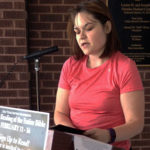- The Explore the Bible lesson for May 12 focuses on Mark 13:24-37.
Mark 13 presents to us the longest block of Jesus’ teaching recorded in Mark’s Gospel. In this teaching from Jesus, the so-called Olivet Discourse, Jesus speaks of signs, future events and cataclysmic upheavals. Given the nature of the material, this chapter presents us with a minefield of interpretive difficulties. In fact, when it comes to the interpretation of Mark 13, the old quip is applicable: “Ask four people, and you’ll get five opinions.”
Unfortunately, some involved in the interpretation of this passage regard their interpretations as the only interpretations, at least the only legitimate ones. We may very well disagree with one another regarding the interpretation of this passage and others like it, and one of us may be wrong. Perhaps, though, we may both be wrong. Consider this, then, an appeal to caution and humility. Let us navigate some of the tricky areas and attempt to capture the central principles of the passage, that is, those things upon which we might all agree.
One of those central principles is this: the risen and ascended Jesus Christ will return to earth. As Acts 1:11 makes clear, Jesus’ return will be a bodily return, not metaphorical or spiritual. True Christian belief has always affirmed that God has acted in history and will do so again. The return of Christ will be the decisive point of history marking the end of this age and the beginning of the next. Given this established point of agreement, let us turn to the text.
Seen! (Mark 13:24-27)
When we read a story that begins, “Once upon a time…,” we understand immediately that we are dealing with a fairy tale. Consequently, we also understand that the story is not intended to insist upon the existence of trolls or talking bears. We know it is a fictional story written to entertain or teach some moral lesson.
Analogously, when we read a first-century writing that speaks of the sun being darkened and the stars falling from the sky (Mark 13:24, 25), we should recognize that we are dealing with an example of Jewish apocalyptic writing. Consequently, we are not necessarily reading the playbook of end-time events any more than we are finding biblical affirmation of the existence of four winds (13:27). Because this passage is an example of Jewish apocalyptic, we need to read the passage according to the ‘rules’ of Jewish apocalyptic, not a set of rules we impose. (For a good introduction to understanding and navigating Jewish apocalyptic and its biblical examples, see B. J. Pitre, “Apocalypticism and Apocalyptic Teaching” in Dictionary of Jesus and the Gospels, 23-33).
With this in mind and in view of the context of all of Mark 13, there is good reason to hear Jesus’ language of the “the Son of Man coming in clouds with great power and glory” (13:26) in conjunction with the destruction of Jerusalem and the temple, which occurred in AD 70, not Jesus’ return. This phrase first appeared in Daniel 7:13-14 where Daniel saw the vision of the son of man coming not to earth but to heaven. The focus of that passage referred to the vindication of the son of man and his triumph. It appears, then, that Jesus drew upon that language and applied it to himself. The very temple where Jesus was rejected would be destroyed, demonstrating God’s vindication of Jesus. Jesus was the one to be trusted, for he was the one who would prevail.
Be Assured! (Mark 13:28-31)
As the expression goes, “The proof of the pudding is in the eating.” The trustworthiness of the prophet may be determined by whether the prophet’s message comes true (see Deuteronomy 18:14-22). In the case of Jesus, he offered to his disciples a bold prediction: “Truly I tell you, this generation will certainly not pass away until all these things have happened” (13:30). “These things” referred to all the things Jesus had said about the impending doom coming upon Jerusalem (13:2ff). It would not be long before the “signs of summer” would be evident. As the stones of the temple were cast down by the Roman legions in AD 70 to complete the sacking of Jerusalem, Jesus as the prophet was vindicated. As Jesus exhorted further, he could be trusted in all things (13:31).
Stay Ready! (Mark 13:32-37)
A subtle shift in Jesus’ words took place following this prediction of the temple’s doom. The phrase “that day” or “that hour” (13:32) was used in an almost technical sense, drawing upon prophetic language speaking of the Day of the Lord (e.g., Amos 8:3; Micah 4:6). Jesus now was speaking beyond the destruction of Jerusalem to the end of the age instituted at his return (see similar usage in 1 Thessalonians 5:2; 2 Thessalonians 2:1-2; 2 Peter 3:10).
With all due respect to those who have exerted tremendous effort into ascertaining the exact time of the return of the Lord, Jesus himself acknowledged that even he did not know. An overemphasis on prognosticating causes us to miss the central truth of Jesus’ words here: “Stay ready because you do not know.” Despite all the debate, confusion and resignation associated with the return of Jesus and this passage in particular, the call to “Stay ready!” is crystal clear.
Sign up for our weekly edition and get all our headlines in your inbox on Thursdays
Conclusion
A central truth emerging from this passage is that Jesus will make good on what he has said he would do. One of those things he has said is that he will return. This is one of the assured convictions of the Christian faith. When, though? Who knows. Could it be today? Yes. Could it be next week? Yes. Could it be 5,000 years from now? Why not?
Given our ignorance of the time of his return, the crucial thing is to be ready at all times. Our current way of life may end at the glorious return of our Savior, but it may very well end in death. Regardless of how this life for us ends, what matters is how this life is lived. Are you ready for the master of the house to appear, or are you sleeping? He’s coming.
Jeremy Greer is assistant professor of religion at East Texas Baptist University in Marshall.















We seek to connect God’s story and God’s people around the world. To learn more about God’s story, click here.
Send comments and feedback to Eric Black, our editor. For comments to be published, please specify “letter to the editor.” Maximum length for publication is 300 words.